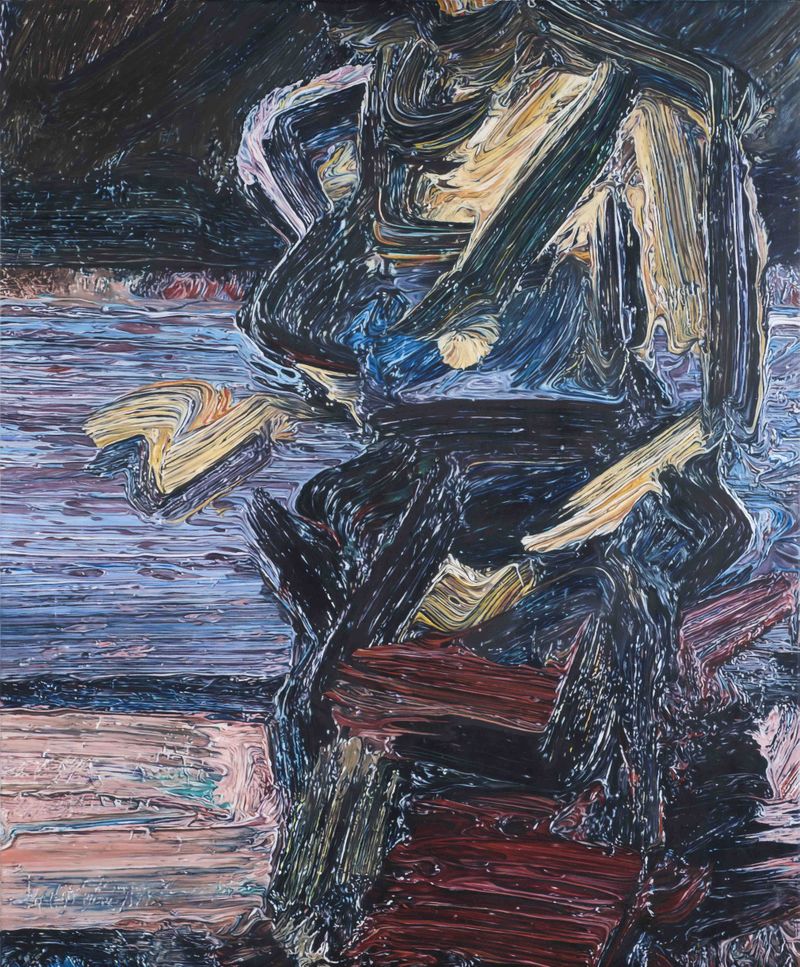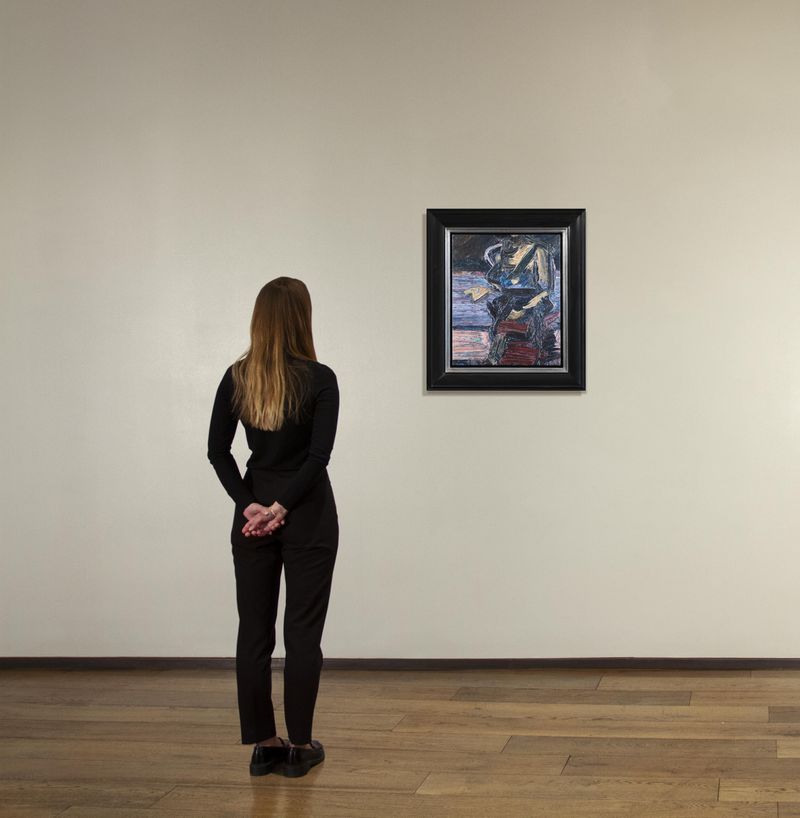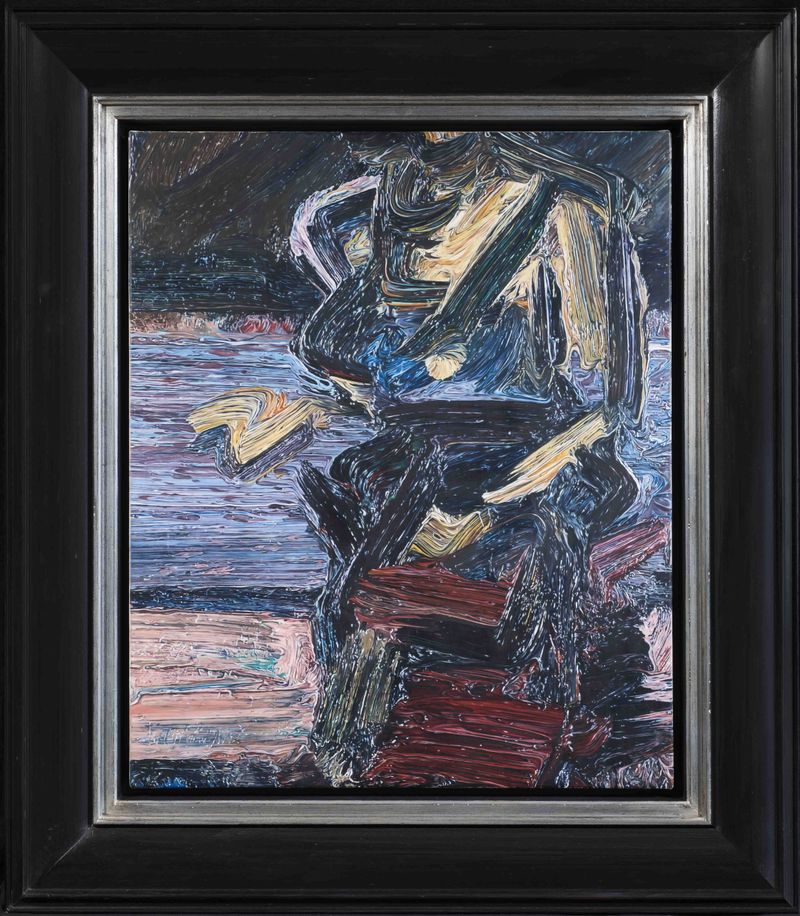Glenn Brown
(British, b.1966)
Dead Relatives
1995
oil on canvas laid on board
57.8 x 47.6 cm (22¾ x 18¾ in.)
signed and dated 'Glenn Brown 1995' (on the verso)
Haunch of Venison, London
Gagosian Gallery, London
Private collection, Dallas (acquired from the above)
Paris, Galerie Ghislaine Hussenot, Glenn Brown, 1997
Hexham, Queen's Hall Art Centre, Glenn Brown, 1996
London, Haunch of Venison, Must I Paint You a Picture?, 2004-05
Painted by Glenn Brown in 1995, Dead Relatives belongs to a number of pioneering early works based on Frank Auerbach’s iconic paintings after Juliet Yardley Mills - a painterly extraction and transmutation which has proven to be the most enduring artistic dialogue of Brown’s career. Here, the masterful flattening of Auerbach's 1987-88 J.Y.M. Seated in the Studio pinpoints the burgeoning of a trans-historical dialogue with icons of art history. Dead Relatives belongs among the breakthrough series of works that launched the ensuring corpus of paintings after Fragonard, Dalí, Rembrandt, Willem de Kooning, and Karel Appel that would come to constitute the mainstay of Brown's virtuoso artistic vocabulary.
Akin to Gerhard Richter before him, Brown explores the validity of painting despite of and dependent upon a visual culture mediated by mass reproduction and the facility of infinite replication. Taking his cue from 1980s appropriation art, Brown represents the next step in the dialogue between photography, painting and post-modern quotation. In the present work, Auerbach’s impassioned brush strokes are emptied of their spontaneous power via a meticulous execution in which every centimetre of the picture's surface is worked across with microscopic intensity. As demonstrated by the lusciously slick appearance of Dead Relatives, Brown paints photographs of paintings, and in so doing, looks to simulate the appearance of the photographic print. The discrepancies between these three stages of transition—from the work of art, to the photographic reproduction, and its transformation back into oil paint—provide the margin for Brown’s own creative and conceptual intervention. Passed through a hyperrealist prism, extravagant brush marks and colour registers are meticulously paraphrased and exaggerated, whilst original compositions are often skewed and turned upside-down. Indeed, contrary to superficial interpretation, Brown’s work ventures beyond mere trompe l’oeil. Auerbach’s J.Y.M. Seated in the Studio is not only faithfully rendered as a hyperrealist painting of an unfaithful reproduction, rather, and most dramatically of all, Brown presents a decapitated version of his original source image. Represented without her head, the corporeal silencing and execution of Auerbach’s sitter invokes a heavily loaded symbolic act that in turn provides a précis for Brown’s entire oeuvre.
Herein the title of the present work, and titling in Brown’s practice as a whole, is extremely significant. Owing to a reliance upon pre-existing and paradigmatic art historical models, Brown’s titles add another layer of intervention and appropriative meaning. Once again subverting authorial conventions, these names are also adopted second-hand from a range of cultural sources ranging from Victorian euphemisms to popular music or zombie horror films. Dead Relatives however refers more explicitly to the conceptual foundation of Brown’s art. As outlined by Francesco Bonami, Brown’s paintings “are attempts to bring back to life—or at least to a facsimile of life, like the work of taxidermist—the masterpieces of the past. But the experiment never works and the paintings decay in the process of coming alive" (Francesco Bonami, 'Paintophagia', Exhibition Catalogue, Liverpool, Tate Liverpool, Glenn Brown, 2009, p. 72). Revivified yet inanimately flattened into a gruesome cipher of expressionistic brushstrokes, impassioned mark-making becomes a shell of mutant undead-life. By ingesting, cannibalising and transforming pre-existing artistic expression from the inside-out, the original author subsists as an absent presence, becoming zombified hosts through which Brown inhabits and evacuates their original significance. The present work, therefore, represents an extraordinary act of reverential emulation and brutal mutilation. By cropping and beheading Auerbach's original composition, Brown invokes an Oedipal act of patricide: paternal power is usurped whilst the antecedent position of authority and artistic expression is at once assumed and reformulated. Art history is thus inherited and reanimated: for Brown, the source images embody the direct descendants, or dead relatives, of his contemporary art practice.
Price:
£325,000 (+5% import VAT)
More artworks by Glenn Brown ▶
You may also like:
Enquire Now
Fill in the form below and we will respond as soon as possible.
Make an offer
Fill in the form below and we will respond as soon as possible.




